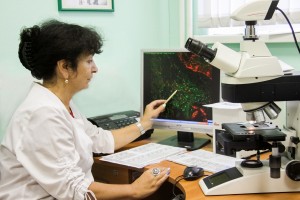The main focus of Almazov Centre is cardiology. Patients with various heart arrhythmias are diagnosed and treated here. Since our Centre is a medical research institution, specialists not only provide medical care, but also study the causes of diseases and search for new diagnostic and treatment methods.
In order to understand the problem of CVD occurrence, one should understand the normal structure of the electrical conduction system of the heart. It is believed that the electrical impulse is the basis of the heartbeat, and therefore the basis of the organism vital activity as a whole. It is initiated in special pacemaker cells, which are located in the sinoatrial node (SA node). According to many specialists, the impulse should be transmitted from these cells to the intermediate cells – the transitory cells, and then to the myocardial contractile cells. But for morphologists who study the structure of the sinoatrial node of the heart, it was always incomprehensible how this happens if the pacemaker cells are surrounded by coarse fibrous tissue that cannot conduct electrical current. How does life begin? How is the impulse transmitted from the pacemaker cells? It was absolutely not clear!
The research laboratory of pathology at Almazov Centre made an amazing discovery. It turns out that there are Cajal cells in the sinoatrial node, and because of them the electronic impulse is transmitted to the heart.
Studying myocardial infarction, researchers at Almazov Centre concluded that when a heart attack occurs, not all cells die. There are always islands of living cardiomyocytes and in these “sleep” islands telocytes are activated. The more of them, the better is the recovery process. Therefore, by increasing the number of telocytes in the affected tissues of the heart, it is possible to stimulate the regeneration process. We just grow the culture of these cells and add them to the right place.
Since telocytes exist in almost all organs and have several phenotypes, it gives unlimited possibilities. “I think that further study of the morphological structure and functions of these cells will open new horizons for the treatment of diseases. This applies not only to cardiology, gastroenterology, obstetrics, but even cosmetology,” highlights Lyubov Mitrofanova, head of Pathology Research Laboratory.

